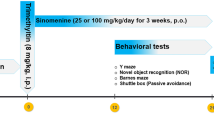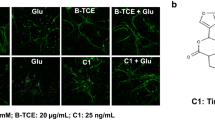Abstract
Background
Despite the immense neuromodulatory potentials of Ginkgo biloba extract as a memory enhancer, its underlying mechanism seems inadequate particularly with regard to its anti-inflammatory properties.
Aim
The objective of the present study is to investigate the protective potentials of Ginkgo biloba extract (GBE) against hippocampal neuronal injury induced by trimethyltin (TMT), a potent neurotoxicant.
Methods
Male SD rats were administered trimethyltin (8.5 mg kg−1 b.wt) single intraperitoneal (i.p.) injection, followed by Ginkgo biloba extract (100 mg kg−1 b.wt i.p) for 21 days.
Results
The co-administration of GBE with TMT showed marked improvement in cognitive functions. Concomitantly, there was a significant decrease in oxidative stress as evident by reduction in MDA and total ROS levels. In addition, there was a marked suppression of astrocyte activation (GFAP), transcription factor NFκB and proinflammatory cytokines (TNF-α, IL-1α, 1L-6), which were found to be elevated by TMT administration. Histopathological observations showed remarkable improvement in hippocampal neuronal injury in the conjunctive group.
Conclusion
Therefore, it is suggested that Ginkgo biloba extract is an effective agent against trimethyltin-induced hippocampal neuronal loss owing to its antioxidative as well as anti-inflammatory properties.
















Similar content being viewed by others
Abbreviations
- 5 HT:
-
Serotonin
- GBE:
-
Ginkgo biloba extract
- GFAP:
-
Glial fibrillary acidic protein
- GPx:
-
Glutathione peroxidase
- GSH:
-
Reduced glutathione
- i.p:
-
Intraperitoneal
- IL:
-
Interleukins
- iNOS:
-
Inducible nitric oxide synthase
- MDA:
-
Malondialdehyde
- NF-κB:
-
Nuclear factor-κB
- ROS:
-
Reactive oxygen species
- TMT:
-
Trimethyltin
- TNF-α:
-
Tumor necrosis factor-α
References
Abdel-Kader R, Hauptmann S, Keil U, Scherping I, Leuner K, Eckert A (2007) Stabilization of mitochondrial function by Ginkgo biloba extract (EGb 761). Pharmacol Res 56:493–502
Bagetta G, Piccirilli S, Duca CD, Morrone LA, Rombola L, Nappi G, Alba JD, Knowles RG, Corasaniti MT (2004) Inducible nitric oxide synthase is involved in the mechanisms of cocaine enhanced neuronal apoptosis induced by HIV-1 gp120 in the neocortex of rat. Neurosci Lett 356:183–186
Baldwin AS (2001) Control of apoptosis, oncogenesis, and cancer therapy resistance by the transcription factor NF-κB. J Clin Invest 107(3):241–246
Beaubrun G, Gray GE (2000) A review of herbal medicines for psychiatric disorders. Psychiatr Serv 51(9):1130–1134
Church WH (2005) Column Chromatography analysis of brain tissue: an advanced laboratory exercise for neuroscience majors. J Undergrad Neurosci Educ 3(Spring):A36–A41
de la Monte SM, Wands JR (2006) Molecular indices of oxidative stress and mitochondrial dysfunction occur early and often progress with severity of Alzheimer’s disease. J Alzheimers Dis 9:167–181
Defeudis FV (2002) Bilobalide and neuroprotection. Pharmacol Res 46:565–568
DeFeudis FV, Drieu K (2000) Ginkgo biloba extract (EGb 761) and CNS functions: basic studies and clinical applications. Curr Drug Targets 1:25–58
Driver AS, Kodavanti PR, Mundy WR (2000) Age related changes in reactive oxygen species production in rat homogenates. Neurotoxicol Teratol 22(2):175–181
El Tabaa MM, Sokkar SS, Ramadan ES, Abd El Salam IZ, Zaid A (2017) Neuroprotective role of Ginkgo biloba against cognitive deficits associated with Bisphenol A exposure: an animal model study. Neurochem Int 108:199–212
Ellman GL (1959) Tissue sulfhydral groups. Arch Biochem Biophys 82:70
Ellman GL, Lourtney KD, Andres VJ (1961) A new and rapid colorimetric determination of acetylcholinesterase activity. Biochem Pharmacol 7:88–95
Flohe L, Gunzler WA (1984) Assays of glutathione peroxidise. Methods of enzymology. Academic, New York, pp 114–121
Geloso MC, Corvino V, Michetti F (2011) Trimethyltin-induced hippocampal degeneration as a tool to investigate neurodegenerative processes. Neurochem Int 58(7):729–738
Han SN, Meydani SN (2000) Antioxidant cytokines and influenza infection in aged mice and elderly humans. J Infect Dis 182:74–80
Harry GJ, Lefebvre d’Hellencourt C (2003) The neuroinflammatory components of the trimethyltin (TMT) model of hippocampal neurodegeneration. In: Wood PL (ed) Neuroinflammation, 2nd Edition, Mechanisms and management. Humana Press, Totowa, pp 301–329
Humanson GL (1961) In: basic procedures—animal tissue technique. Part-1, pp 130–132
Ismail AF, El-Sonbaty SM (2016) Fermentation enhances Ginkgo biloba protective role on gamma-irradiation induced neuroinflammatory gene expression and stress hormones in rat brain. J Photochem Photobiol 158:154–163
Itoh J, Nabeshima T, Kameyama T (1991) Utility of an elevated plus-maze for dissociation of amnesic and behavioral effects of drugs in mice. Eur J Pharmacol 194:71–76
Kampkotter A, Pielarski T, Rohrig R, Timpel C, Chovolou Y, Watjen W, Kahl R (2007) The Ginkgo biloba extract EGb761 reduces stress sensitivity, ROS accumulation and expression of catalase and glutathione S-transferase 4 in Caenorhabditis elegans. Pharmacol Res 55:139–147
Kaur S, Nehru B (2013) Alteration in glutathione homeostasis and oxidative stress during the sequelae of trimethyltin syndrome in rat brain. Biol Trace Elem Res 153:299–308
Kaur S, Chhabra R, Nehru B (2013) Ginkgo biloba extract attenuates hippocampal neuronal loss and cognitive dysfunction resulting from trimethyltin in mice. Phytomedicine 20:178–186
Kim MS, Bang JH, Lee J, Han JS, Baik TG, Jeon WK (2016) Ginkgo biloba L. extract protects against chronic cerebral hypoperfusion by modulating neuroinflammation and the cholinergic system. Phytomedicine 23:1356–1364
Kobuchi H, Droy-Lefaix MT, Christen Y, Packer L (1997) Ginkgo biloba extract (EGb 761): inhibitory effect on nitric oxide production in the macrophage cell line RAW 264.7. Biochem Pharmacol 53:897–903
Koczyk D, Oderfeld-Nowak B (2000) Long-term microglial and astroglial activation in the hippocampus of trimethyltin intoxicated rats: stimulation of NGF and trkA immunoreactivities in astroglia but not in microglia. Int J Dev Neurosci 18:591–606
Kwak P, Lim SC, Han SR, Shon YM, Kim YI (2012) Supra-additive neuroprotection by renexin, a mixed compound of Ginkgo biloba extract and cilostazol, against apoptotic white matter changes in rat after chronic cerebral hypoperfusion. J Clin Neurol 8:284–292
Lavie L, Vishnevsky A, Lavie P (2004) Evidence for lipid peroxidation in obstructive sleep apnea. Sleep 27:123–128
Lee SM, Yune TY, Kim SJ, Kim YC, Oh YJ, Markelonis GJ, Oh TH (2004) Minocycline inhibits apoptotic cell death via attenuation of TNF-alpha expression following iNOS/NO induction by lipopolysaccharide in neuron/glia co-cultures. J Neurochem 91:568–578
Liu Y, Imai H, Sadamatsu M, Tsunashima K, Kato N (2004) Cytokines participate in neuronal death induced by trimethytlin in the rat hippocampus via type II glucocorticoid receptors. Neurosci Res 50:209–217
Louajri A, Harraga S, Godot V, Toubin G, Kantelip JP, Magnin P (2001) The effect of Ginkgo biloba extract on free radical production in hypoxic rats. Biol Pharm Bull 24(6):710–712
Marcocci L, Maguire JJ, Droy-Lefaix MT, Packer L (1994) The nitric oxide-scavenging properties of Ginkgo biloba extract EGb 761. Biochem Biophys Res Commun 201:748–755
Mattson MP (2007) Mitochondrial regulation of neuronal plasticity. Neurochem Res 32:707–715
Miyamoto M, Shintani M, Nagaoka A, Nagawa Y (1984) Lesioning of rat basal forebrain leads to memory impairments in passive and active avoidance tasks. Brain Res 328:97–104
Oliveira DR, Sanadaa PF, Saragossa AC, Innocenti LR, Oler G, Cerutti JM, Cerutti SM (2009) Neuromodulatory property of standardized extract Ginkgo biloba L. (EGb 761) on memory: behavioral and molecular evidence. Brain Res 12(69):68–89
Osman NM, Amer AS, Abdelwahab S (2016) Effects of Ginko biloba leaf extract on the neurogenesis of the hippocampal dentate gyrus in the elderly mice. Anat Sci Int 91(3):280–289
Paganelli RA, Benetoli A, Milani H (2006) Sustained neuroprotection and facilitation of behavioral recovery by the Ginkgo biloba extract, EGb 761, after transient forebrain ischemia in rats. Behav Brain Res 174:70–77
Pearse AGE (1968) In: Histochemistry, theoretical and applied, vol I, 3rd edn. Churchill Livingstone, London, p 660 (Basic studies and clinical applications. Curr Drug Targets 1:25–58)
Raddassi K, Berthon B, Petit JF, Lemaire G (1994) Role of calcium in the activation of mouse peritoneal macrophages: induction of NO synthase by calcium ionophores and thapsigargin. Cell Immunol 53:443–455
Reali C, Scintu F, Pillai R, Donato R, Michetti F, Sogos V (2005) S100b counteracts effects of the neurotoxicant trimethyltin on astrocytes and microglia. J Neurosci Res 81:677–686
Rocher M-N, Carré D, Spinnewyn B, Schulz J, Delaflotte S, Pignol B, Chabrier P-E, Auguet M (2011) Long-term treatment with standardized Ginkgo biloba extract (EGb 761) attenuates cognitive deficits and hippocampal neuron loss in a gerbil model of vascular dementia. Fitoterapia 82:1075–1080
Rodriguez de Turco EB, Droy-Lefaix MT, Bazan NG (1993) GBE 761 inhibits stress-induced polydipsia in rats. Physiol Behav 53:1001–1002
Rogue P, Malviya AN (1996) Inhibition of protein kinase C by Ginkgo biloba extract (EGb 761). In: Christen Y, Droy-Lefaix MT, Macias Nunaz JF (eds) Advances in Ginkgo biloba extract (EGb 761) on neuronal plasticity. Elseiver, Paris, pp 1–6
Rohl C, Sievers J (2005) Microglia is activated by astrocytes in trimethyltin intoxication. Toxicol Appl Pharmacol 204:36–45
Sharma N, Nehru B (2015) Characterization of the lipopolysaccharide induced model of Parkinson’s disease: role of oxidative stress and neuroinflammation. Neurochem Int 87:92–105
Sharma N, Sharma S, Nehru B (2017) Curcumin protects dopaminergic neurons against inflammation-mediated damage and improves motor dysfunction induced by single intranigral lipopolysaccharide injection. Inflammopharmacology. doi:10.1007/s10787-017-0346-z
Trabucco A, Di Pietro P, Nori SL, Fulceri F, Fumagalli L, Paparelli A, Fornai F (2009) Methylated tin toxicity a reappraisal using rodents models. Arch Ital Biol 147:141–153
Tulsulkar J, Shah ZA (2013) Ginkgo biloba prevents transient global ischemia-induced delayed hippocampal neuronal death through antioxidant and anti-inflammatory mechanism. Neurochem Int 62:189–197
Vauzour D, Vafeiadou K, Rodriguez-Mateos A, Rendeiro C, Spencer JPE (2008) The neuroprotective potential of flavonoids: a multiplicity of effects. Genes Nut 3(3–4):115–126
Wadsworth TL, Koop DR (2001) Effects of Ginkgo biloba extract (EGb 761) and quercetin on lipopolysaccharide-induced signalling pathways involved in the release of nitric oxide. Chem Biol Interact 137:43–58
Wei Z, Peng Q, Lau BH, Shah V (1999) Ginkgo biloba inhibits hydrogen peroxide-induced activation of nuclear factor kappa B in vascular endothelial cells. Gen Pharmacol 33:369–375
Wills ED (1966) Mechanism of lipid peroxide formation in animal tissues. Biochem J 99:667–676
Yoshitake T, Yoshitake S, Kehr J (2010) The Ginkgo biloba extract EGb 761® and its main constituent flavonoids and ginkgolides increase extracellular dopamine levels in the rat prefrontal cortex. Br J Pharmacol 159:659–668
Yung HW, Bal-Price AK, Brown GC, Tolkovsky AM (2004) Nitric oxide-induced cell death of cerebrocortical murine astrocytes is mediated through p53- and Bax-dependent pathways. J Neurochem 89:812–821
Zahler WL, Cleland WW (1968) A specific and sensitive assay for disulfides. J Biol Chem 243(4):716–719
Zaki et al (2015) Neuroprotective effects of Ginkgo biloba extract on brain damage induced by γ-radiation and lead acetate. Int J Sci Res Publ 5(9):716–726
Zhang L, Li L, Prabhakaran K, Borowitz JL, Isom GE (2006) Trimethyltin-induced apoptosis is associated with upregulation of inducible nitric oxide synthase and Bax in a hippocampal cell line. Toxicol Appl Pharmacol 216:34–43
Acknowledgements
The financial assistance to Dr. Sukhwinder Kaur in the form of junior research fellowship from the University Grant Commission is highly acknowledged.
Author information
Authors and Affiliations
Corresponding author
Ethics declarations
Conflict of interest
We wish to confirm that there are no known conflicts of interest associated with this publication and there has been no significant financial support for this work that could have influenced its outcome.
Rights and permissions
About this article
Cite this article
Kaur, S., Sharma, N. & Nehru, B. Anti-inflammatory effects of Ginkgo biloba extract against trimethyltin-induced hippocampal neuronal injury. Inflammopharmacol 26, 87–104 (2018). https://doi.org/10.1007/s10787-017-0396-2
Received:
Accepted:
Published:
Issue Date:
DOI: https://doi.org/10.1007/s10787-017-0396-2




